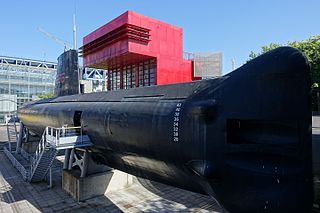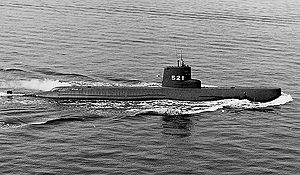
The Delfinen-class submarines were the first class of submarines constructed for the Royal Danish Navy following World War II. They were designed and built within Denmark, with first three boats of the class financed by Denmark. The fourth was financed by the United States under the Cost Share program. Constructed between 1956 and 1963, the class comprising four submarines entered service in 1961 and the last taken out of service in 1990. Replaced by the Norwegian Kobben class, three of them were scrapped while a fourth was converted into a museum ship and remains on display at the Aalborg Maritime Museum.

The Rubis class is a series of nuclear-powered attack submarines operated by the French Navy. The class comprises six vessels, the first entering service in 1983 and the last in 1993, with another two being cancelled. All six submarines of the Rubis class are based at Toulon and are part of the Escadrille de sous-marins nucléaires d'attaque. Smaller than contemporary designs of other major world navies, the Rubis class shares many of its system designs with the conventionally-powered Agosta class. In the late 1980s, the Rubis class was proposed as an export to Canada in their plan to acquire nuclear-powered submarines.

USS Frederick (LST-1184) was a Newport-class tank landing ship which replaced the traditional bow door-design tank landing ships (LSTs) of the United States Navy. The ship was named after the city of Frederick, Maryland and Frederick County, Maryland. The vessel entered service in 1970 with the United States Pacific Fleet and saw service during the Vietnam War, and the Persian Gulf War earning three battle stars. The ship was decommissioned in 2002 and put up for sale.

The Vidar-class minelayers consists of the two ships, HNoMS Vidar and HNoMS Vale built by Mjellem & Karlsen in Bergen for the Royal Norwegian Navy in 1977 and 1978. Used as multi-role ships, the Vidar class were tasked with minelaying, personnel/cargo transport, fisheries protection, torpedo-recovery ships and as anti-submarine warfare escorts in Norwegian service. In 2003, Vale was transferred to the Latvian Navy via donation and renamed Virsaitis and used as a flagship and tender to patrol craft. In 2006, Vidar was transferred to the Lithuanian Navy and renamed Jotvingis and served as flagship and tender to mine countermeasures craft. Both vessels had their ASW equipment removed upon transfer.

The Claud Jones-class destroyer escorts were four destroyer escorts built for the United States Navy in the late 1950s. These ships were a diesel-powered version of the earlier Dealey class and were designed with the aim of producing a cheaper ship suitable for rapid production in wartime. These ships also had reduced armament and speed compared to their predecessors. They were not seen as effective anti-submarine warfare vessels by the United States Navy and were sold after only 15 years service to the Indonesian Navy.

Argonaute is an Aréthuse-class submarine, and the fourth ship of the French Navy to bear the name. Launched on 29 June 1957, the submarine served as flagship within the Toulon submarine squadron. Argonaute was decommissioned on 31 July 1982. The vessel was converted to a museum ship in 1989 and located in Paris.

The Aréthuse class were submarines built for the French Navy in the 1950s. They were designed as attack submarines for anti-submarine warfare and were referred to as Sous-marins de Chasse by the French Navy. These submarines had advanced sensors and were very quiet. They were influenced by the World War II German Type XXIII U-boats. The Daphné class are an enlarged version built for the French, Pakistani, Portuguese, Spanish and South African navies.

The João Belo class, also known as Comandante João Belo class, is a class of four frigates of French design, based on the Commandant Rivière class but fitted for tropical service. Ordered by the Portuguese Navy in 1964, the four ships of this class were constructed at the shipyard in Nantes, France between 1965 and 1967. The first ship entered Portuguese service in 1967. The frigates were used for ocean patrol of Portuguese colonies and later, joined NATO's STANAVFORLANT unit. The first unit was discarded in 2003, followed by a second in 2004. The final two ships were taken out of service in 2008 sold to the Uruguayan Navy. The third ship was discarded in 2021, with one ship remaining in service.

The Asashio-class submarine is a submarine class of Japanese Maritime Self-Defense Force comprising four boats. This class is the successor of Ōshio. The class were the first fleet submarines constructed for post-war Japan. The first submarine was authorized as part of the 1963 shipbuilding programme. Their design improved on previous Japanese classes by being larger to obtain better seaworthiness with greater torpedo stowage. The class entered service in the late 1960s and remained as such until the mid-1980s when they were taken out of service.

HMS Olympus was an Oberon-class submarine that served in the Royal Navy, and later in the Canadian Forces as a submarine trainer.

USS Boulder (LST-1190) was the twelfth of twenty Newport-class tank landing ships of the United States Navy (USN) which replaced the traditional bow door-design tank landing ships (LSTs). Named after the county in Colorado, the ship was constructed by National Steel and Shipbuilding Company of San Diego, California. The LST was launched in 1970 and was commissioned in 1971. Boulder was assigned to the United States Atlantic Fleet and deployed in the Caribbean and Mediterranean Seas. In 1980, the ship was transferred to the Naval Reserve Force. In 1988, Boulder ran aground off Norway during a military exercise. The vessel was decommissioned in 1994 and laid up at the Naval Inactive Ship Maintenance Facility in Philadelphia, Pennsylvania. The ship was struck from the Naval Vessel Register in 2008 and is awaiting disposal.

USS Racine (LST-1191) was the thirteenth of twenty Newport-class tank landing ships of the United States Navy (USN) which replaced the traditional bow door-design tank landing ships (LSTs). The second ship named after the city in Wisconsin, the ship was constructed by National Steel and Shipbuilding Company of San Diego, California. The LST was launched in 1970 and was commissioned in 1971. Racine was assigned to the United States west coast and deployed to the western Pacific Ocean during the Vietnam War. The ship was transferred to the Naval Reserve Force in 1981. The LST was decommissioned in 1993 and placed in reserve. Racine was struck from the Naval Vessel Register in 2008 and after an attempted sale to Peru failed, was discarded as a target ship during a sinking exercise in July 2018.

USS Manitowoc (LST-1180) was the second ship of the Newport-class tank landing ships which replaced the traditional bow door-design tank landing ships (LSTs) in service with the United States Navy. Manitowoc was constructed by the Philadelphia Naval Shipyard in Philadelphia, Pennsylvania and launched in 1969 and entered service in 1970.

USS Bristol County (LST-1198) was the last of the twenty Newport-class tank landing ships of the United States Navy (USN) which replaced the traditional bow door-design tank landing ships (LSTs). The LST was constructed by National Steel and Shipbuilding Company of San Diego, California. Bristol County was launched in 1971 and commissioned into the USN in 1972. Bristol County was assigned to the United States Pacific Fleet and remained in service until 1994 when it was decommissioned. Sold to Morocco that year, the vessel was recommissioned into the Royal Moroccan Navy as Sidi Mohammed Ben Abdellah. The ship remains in service.

The João Coutinho-class corvettes were a series of warships built for the Portuguese Navy for service in Portugal's African and Indian colonies. Initially rated as frigates, they were downgraded first to corvettes and then patrol vessels with age. They were designed in Portugal by naval engineer Rogério de Oliveira, but the urgent need of their services in the Portuguese Colonial War meant that the construction of the ships was assigned to foreign shipyards. Six ships were built; the first three ships were built by Blohm & Voss and the remaining three by Empresa Nacional Bazán. The ships were launched in 1970 and 1971. The relative cheap cost of the design led to it being the basis of several other classes in other navies. From 1970 until the end of the conflict in 1975, the corvettes were used for patrol and fire-support missions in Angola, Mozambique, Guinea and Cape Verde. After the African colonies gained their independence, the corvettes were assigned to patrol duties in Portuguese territorial waters.

The Poti class was the NATO reporting name for a group of anti-submarine warfare (ASW) corvettes built for the Soviet Navy. The Soviet designation was Project 204 small anti-submarine ships. These ships were the first Soviet warships powered by gas turbine engines; two propellers were mounted in tunnels to give a very shallow draught. A twin 57 mm (2 in) gun mounting provided self-defence. Three ships of the class were exported to Romania and six to Bulgaria during the Cold War. By 2008, all ships of the class were no longer extant.

The Don-class submarine tender was the NATO reporting name for a group of seven submarine tenders built for the Soviet Navy in the late 1950s. The Soviet designation was Project 310 Batur. Evolving from a need for dispersed basing of submarines in the advent of a nuclear war, the ships were designed to support distant operations of the Soviet Union's submarine fleet, capable of repairing and resupplying. However, the Soviets returned to stationary basing of their submarines and the Don class were later converted into flagships. One vessel was exported to Indonesia in 1962 and due to the ship's heavy armament, was used primarily for patrol duties. The ships of the Don class were removed from service in the mid 1990s and broken up for scrap.

BAP Abtao (SS-42) is an Abtao-class submarine of the Peruvian Navy. The vessel which was originally named BAP Tiburón ("Shark"), was constructed by the American Electric Boat company in the United States and launched in 1953. The Abtao class were the last submarines constructed by the United States for the export market. The submarine entered service in 1954 and by presidential decree, was renamed Abtao for the battle during the Chincha Islands War.
The Abtao class were four submarines of the Peruvian Navy that entered service between 1954 and 1957. They are also known as the Lobo class and the Dos de Mayo class and were constructed in the United States to a design based upon the United States Navy's Mackerel class. They were the last submarines to be constructed by the United States for the export market. All four submarines were powered by a diesel-electric system and armed with six 21-inch (533 mm) torpedo tubes. Two of the submarines also mounted a 5 in (127 mm)/25 caliber gun. The four submarines, initially named for animals, were all renamed in 1957 for famous Peruvian battles. Beginning in 1991, the submarines were taken out of service, with the last decommissioned in 1999. One, BAP Abtao, is a museum ship located in Lima, Peru.
SAS Spear, initially known as the SAS Maria van Riebeeck, was a Daphné-class submarine of the South African Navy (SAN). Built in France during the 1960s, the boat was the SAN's first submarine. It was scrapped in June–July 2003.


















